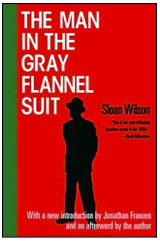Books |
The Man in the Gray Flannel Suit
Sloan Wilson
By
Published: Jul 22, 2010
Category:
Fiction
Before there was "Mad Men," there was….
If you’ve got a long memory, like old movies or have chatty parents, a 1955 novel comes to mind.
Okay, so Tom Rath isn’t an ad man at the start of Sloan Wilson’s bestseller, "The Man in the Gray Flannel Suit." He works at a foundation which funds scientific research and the arts. But he surely fits the "Man Men" profile. He drinks martinis, and he has a wife and three kids stashed in Connecticut, and better believe he’ll do a lot to make more money — it’s 1953, he’s 33, and he’s earning just $7,000 a year. He still has his dreams, but….
So when he gets hired at United Broadcasting and the CEO takes a shine to him, Tom Rath is on his way. He and Betsy can move up from their dilapidated little house in Westport. They can buy a better car. He can take out plenty of life insurance. Maybe they can even sneak off to Florida in the winter without the kids. [To buy the paperback from Amazon, click here. For the Kindle edition, click here.]
There are just a few problems in the way.
First, for Tom, is Post-Traumatic Stress Disorder — not that anyone called it that back then. For Tom was quite the hero in World War II. He killed 17 men, sometimes at close range. He also, accidentally, killed his best friend. And, in Italy, he fathered a child. It is a measure of those times that the war memories seem to present no big issue. An illegitimate kid in Italy? Huge.
Second is money. The way you get it is to rise in a large corporation. But nothing about the workaholic CEO at United Broadcasting inspires Tom to pledge allegiance to his job. The speech he’s asked to write is just words, and once he turns it in, other executives step in to gut any original ideas Tom had failed to flatten.
Sloan Wilson takes Tom Rath through all the stations of the modern cross. The job interview (Tom restrains himself from blurting out that he could care less about television, he just wants to buy “a more expensive house and a better brand of gin”). Kids who watch too much TV. A marriage that’s turned perfunctory ("How did things go with you today?" "Not so well." "Why, what happened?" "Barbara’s got the chicken pox and the washing machine broke down.") And — doesn’t this read like a cleaned-up version of "Man Men"? — the sexless but hard-drinking suburban parties:
On Greentree Avenue cocktail parties started at seven-thirty, when the men came home from New York, and they usually continued without any dinner until three or four o’clock in the morning. Somewhere around nine-thirty in the evening, Martinis and Manhattans would give way to highballs, but the formality of eating anything but hors d’oeuvres in-between had been entirely omitted.
The stunner: Tom not only isn’t the man in a gray flannel suit, he doesn’t want to become that guy. So as much as Wilson takes us into the world of 30th floor offices, his real aim is to show Tom’s struggle to avoid the fate of the dead souls all around him.
Conformity and rebellion — when the hero’s a clean-cut guy with a fine wife, that’s a winning formula. “The Man in the Gray Flannel Suit” sold two million copies. It became an "important" movie, starring Gregory Peck, Jennifer Jones and Frederic March. [To buy the DVD from Amazon, click here.]
Forget the shorthand. Go back to the original text. In Tom and Betsy Rath, you may find people who face some challenges you’ve seen before — in "Mad Men." But Tom and Betsy’s came first. And you’ll turn pages rapidly to see if they succeed.
BONUS VIDEO: The movie premiere


